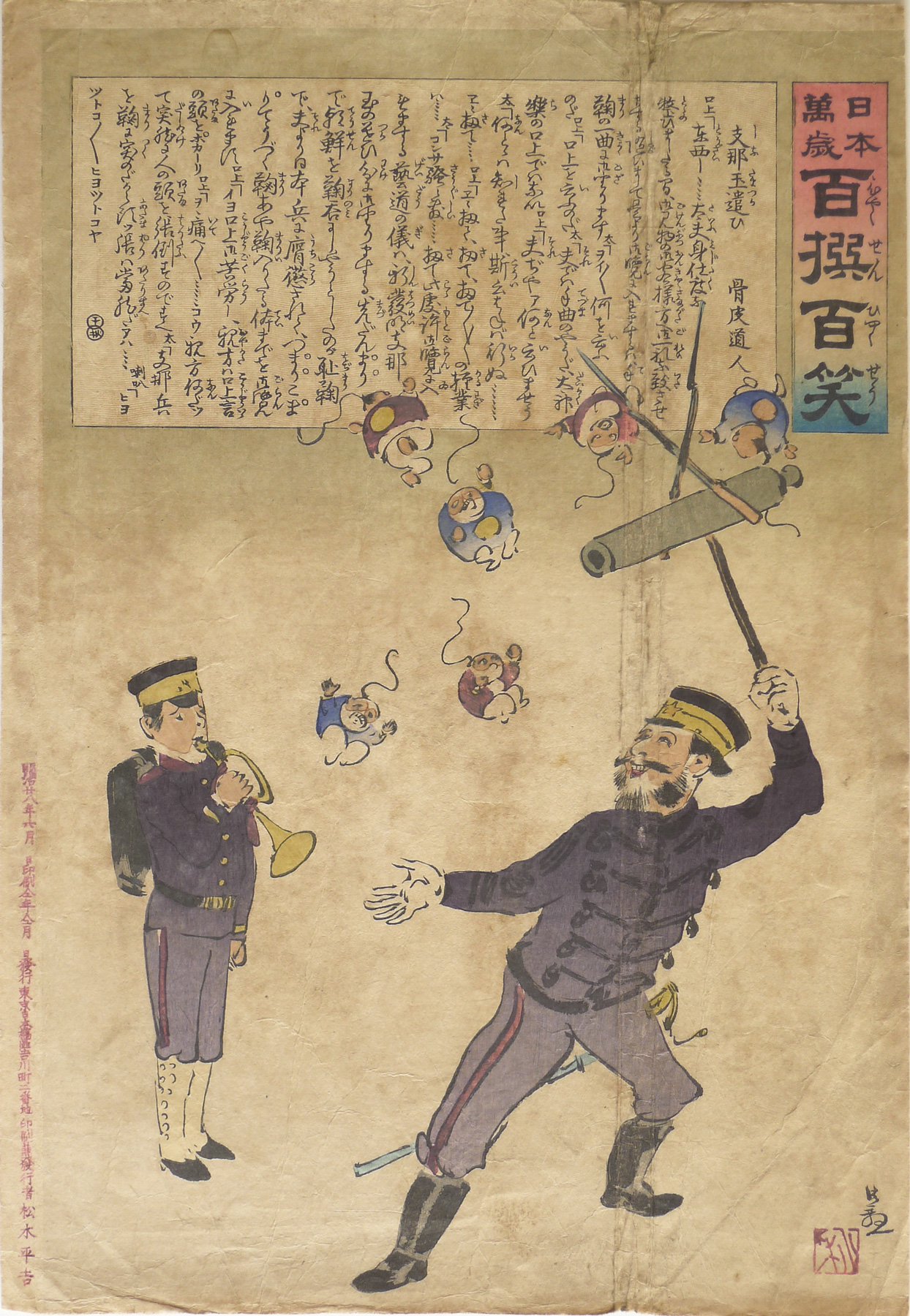About This Print
This print is one of fifty prints from the first part of the three part series One Hundred Victories, One Hundred Laughs. (Hyakusen hyakushô) created by the artist Kobayashi Kiyochika (1847-1915), the writer Nishimori Takeki (1861-1923), alias Koppi Dōjin, and the publisher Matsuki Heikichi (1870-1931).
Source: Playthings and Pastimes in Japanese Prints, Lea Baten, Weatherhill, 1995, p. 118
"A bearded Japanese officer is juggling with six small pig-tailed Chinese men in the form of dolls. To show how easy it is to defeat the Chinese, he plays with one hand. With the other hand he balances a cannon and two rifles on a stick. A young bugler provides music for the act."
In commenting on Kiyochika's samurai background and his contempt for the enemy and the racist depictions of the defeated Chinese foe, Baten comments:
The print is an interesting one for our study because the officer is playing a popular children's game called o-jamma (or ote-dama), which involves throwing small rag dolls or bags stuffed with peas, rice, or grain in the air and catching them alternately in a regular and continuous movement. It is not surprising that the Chinese were mocked, for a Japanese samurai's highest aspirations were to be indifferent to suffering and to die for his master without hesitation. In this light, the print echoes Johan Huizinga's words in his book Homo Ludens, "The Japanese samurai held the view that what was serious for the common man was but a game for the valiant."
About The Series One Hundred Victories, One Hundred Laughs
| The print is an interesting one for our study because the officer is playing a popular children's game called o-jamma (or ote-dama), which involves throwing small rag dolls or bags stuffed with peas, rice, or grain in the air and catching them alternately in a regular and continuous movement. It is not surprising that the Chinese were mocked, for a Japanese samurai's highest aspirations were to be indifferent to suffering and to die for his master without hesitation. In this light, the print echoes Johan Huizinga's words in his book Homo Ludens, "The Japanese samurai held the view that what was serious for the common man was but a game for the valiant." |
This series One Hundred Victories, One Hundred Laughs was issued in three parts and presented parodies of the enemy, the Chinese in the Sino-Japanese War of 1894-1895 and ten years later the Russians in the Russo-Japanese War of 1904-1905. The first part of the series titled Long Live Japan: One Hundred Victories, One Hundred Laughs, consisting of fifty prints, was issued between September 1894 and August 1895. The second part of the series titled Magic Lantern Society: One Hundred Victories, One Hundred Laughs, consisting of twelve prints, was issued between November 1895 and December 1896. Both of these parts parodied (often in a racist manner) the Chinese people, leadership and war effort. The third and last part of the series, consisting of eight-six prints, used the same title as the first part Long Live Japan: One Hundred Victories, One Hundred Laughs. Issued between April 1904 and April 1905, the prints parodied the Russian war effort. For more information about the series see the article One Hundred Victories, One Hundred Laughs on this site.
Print's Inscription - Japanese
Source: University of Vienna website http://ukiyoe.univie.ac.at/detail.asp?docid=943&lang=j&first=1支那(しな)玉遣(たまつか)ひ 骨皮道人
口上「東西(とうざい)東西(とうざい) - 太夫(たいふ)身支度(みじたく)お/ 整(ととの)ひましたる間、御見物(ごけんぶつ)の御客様方(おんきやくさまがた)へ御(ご)一礼(れい)お致(いた)させ/ まする、随(したが)ひまして是より御覧(ごらん)に入れまするハ、手(て)/鞠(まり)の一曲(きよく)に御座(ござ)ります
太「ヲイヲイ何(なに)を云(い)ふ/ のだ
口上「口上を云(い)ふのだ
太「夫(それ)でハ手曲(てづま)のやうだ、大神(だいかぐ)/楽(ら)の口上でハない
口上「夫(それ)ぢやァ何(なん)と云(い)ひませう/
太「何ととハ知(し)れた事、斯(こう)云(い)はねバ行(いか)ぬ/ エエ扨(さ)て、
口上「エエ扨(さ)て、扨て、扨て扨て扨ての軽業(かるわざ)/ ハ
太「コンナ騒々数(さうざうしい)扨(さ)て此處(ここ)許(もと)御覧(ごらん)に入(い)/ れまする芸道(げいどう)の儀(ぎ)ハ、新発明(しんはつめい)支那/玉の遣(つか)ひ分(わけ)に御座りまする、先(まづ)だんまり/ で、朝鮮(てうせん)を鞠呑(まりのミ)にしたのが恥毬(はぢまり)で、夫(それ)より日本兵に・懲(うちこら)されて、つまりこま/りてうづく鞠(まり)あや鞠(まり)入(い)りたる体(てい)までを御覧(ごらん)/ に入(い)れます
口上「イヨ口上(こうじやう)御苦Γ崖音(ごくらう)御苦Γ崖音(ごくらう)、親方(おやかた)ハ口上言(こうじやういい)/ の頭(あたま)をポカーリ
口上「ヲヲ痛(いて)へ痛(いて)へ コウ親方何(なん)だッ/て突抜(だしぬけ)に人(ひと)の頭(あたま)を張倒(はりたふ)すのですへ
太「支那兵/ を鞠(まり)に突(つく)のだから頭(あたま)ッ張(はり)ハ当然(あたりまへ)だアハハハハ
喇叭「ヒヨ/ットコヒヨットコヒヨットコヤ
Shina tama-tsukai Koppi Dōjin
Kōjō „Tōzai Tōzai …Tyū mijitaku o / totonoimashitaru aida, go-kenbutsu no on-kyaku-sama-gata e go-ichirei o itasase/masuru, shitagaimashite kore yori go-ran ni iremasuru wa te/marin o ikkyoku ni gozarimasu
Print Details
| IHL Catalog | #235 |
| Title or Description | The juggler of the Chinese ball Shinadama-tsukai or Shina tama-tsukai 支那玉遣ひ |
| Series | Long Live Japan: One Hundred Victories, One Hundred Laughs [also translated as Long Live Japan! One Hundred Selections, One Hundred Laughs] Nihon banzai: Hyakusen hyakushō 日本萬歳 百撰百笑 [日本万歳 百撰百笑] |
| Artist | Kobayashi Kiyochika (1847-1915) |
| Signature | Kiyochika |
| Seal | Kobayashi |
| Publication Date | June 1895 (Meiji 28) |
| Publisher | Matsuki Heikichi (松木平吉) proprietor of Daikokuya |
| Impression | excellent |
| Colors | good |
| Condition | poor - soiling and wrinkling throughout; ½” wide vertical fold, full margins, not backed |
| Genre | ukiyo-e - senso-e (Sino-Japanese War); giga; fūshiga |
| Miscellaneous | |
| Format | vertical oban |
| H x W Paper | 14 1/8 x 9 3/4 in. (35.9 x 24.8 cm) |
| H x W Image | 13 7/8 x 9 3/8 in. (35.2 x 23.8 cm) |
| Literature | Playthings and Pastimes in Japanese Prints, Lea Baten, Weatherhill, 1995, p. 118 |
| Collections This Print | The Tsubouchi Memorial Theatre Museum of Waseda University 201-1825; Princeton University Art Museum 208-102.30 |


